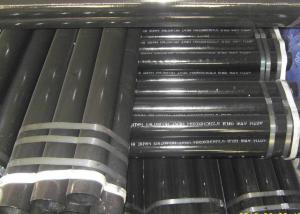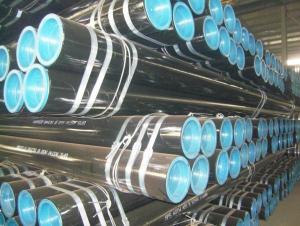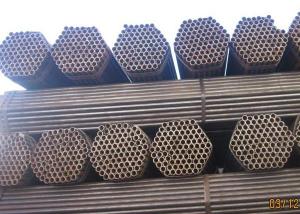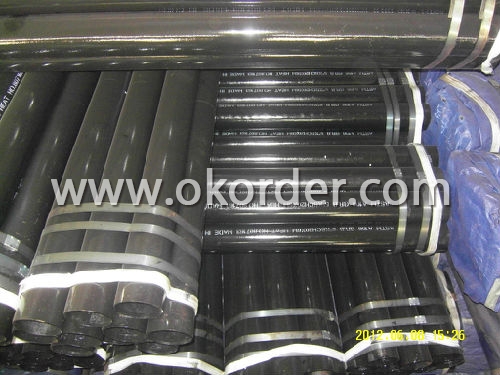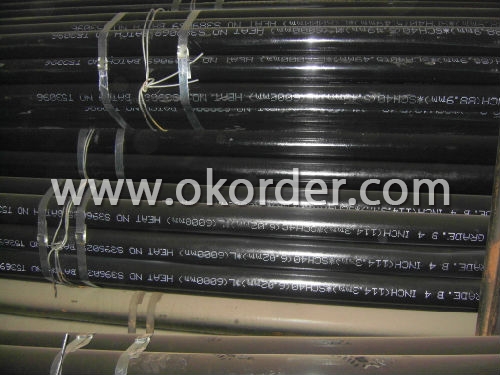Seamless Line Pipe X65
- Loading Port:
- Tian Jin Port
- Payment Terms:
- TT or LC
- Min Order Qty:
- 50MT m.t.
- Supply Capability:
- 5000 Tons Per Month m.t./month
OKorder Service Pledge
OKorder Financial Service
You Might Also Like
| |||||||||||||||||||||||||||||||||||||||||||||||||||||||||||||||||||||||||||||||||||||||||||||||||||||
|
- Q:Can steel pipes be used for water supply networks?
- Yes, steel pipes can be used for water supply networks. They are commonly used due to their durability, strength, and resistance to corrosion. However, proper coatings and maintenance are necessary to prevent rusting and ensure the quality of the water supply.
- Q:What are the different methods of pipe coating for steel pipes?
- There are several methods of pipe coating for steel pipes, including fusion-bonded epoxy (FBE) coating, three-layer polyethylene (3LPE) coating, three-layer polypropylene (3LPP) coating, and liquid epoxy coating. Each method offers different levels of protection against corrosion, abrasion, and other environmental factors, ensuring the durability and longevity of the steel pipes.
- Q:What are the different methods of lining steel pipes?
- There are several methods of lining steel pipes, including cement lining, epoxy lining, polyethylene lining, and bituminous lining. These methods are used to protect the inside surface of the steel pipes from corrosion, erosion, and other forms of damage, ensuring their longevity and optimal performance.
- Q:Can steel pipes be used for steam applications?
- Yes, steel pipes can be used for steam applications. Steel is a widely used material in steam systems due to its high strength, durability, and resistance to high temperatures and pressure. It is commonly used in industries such as power generation, refineries, and petrochemical plants for carrying and distributing steam. However, it is important to ensure that the steel pipes are properly designed, installed, and maintained to withstand the specific conditions and requirements of steam applications.
- Q:What are the common maintenance practices for steel pipes?
- Steel pipes require regular inspections, cleaning, and corrosion prevention as part of their maintenance. It is crucial to conduct inspections frequently to detect any signs of damage or wear. These inspections can involve visual assessments and non-destructive testing methods like ultrasonic or magnetic particle inspection. Scheduling inspections ensures early detection of issues, allowing for prompt resolution. Cleaning is also a vital maintenance practice for steel pipes. It involves the removal of dirt, debris, and scale that may accumulate on both the inside and outside of the pipes. Regular cleaning prevents blockages, enhances flow efficiency, and reduces the risk of corrosion. Corrosion prevention plays a significant role in maintaining steel pipes. Different methods, such as applying protective coatings, utilizing cathodic protection systems, or implementing corrosion inhibitors, can be employed to safeguard the pipes. These measures extend the pipes' lifespan and preserve their structural integrity over time. Additional maintenance practices may include repairing or replacing damaged sections of the pipes, maintaining proper insulation to prevent heat loss or gain, and monitoring the pipes for any signs of leakage or pressure drops. In summary, regular inspections, cleaning, and corrosion prevention are vital maintenance practices for steel pipes. Implementing these practices prolongs the pipes' lifespan and allows for the identification and resolution of potential issues before they cause significant damage or disruptions.
- Q:How are steel pipes insulated to prevent condensation?
- Steel pipes are typically insulated using materials such as foam or fiberglass that have low thermal conductivity. These insulating materials create a barrier that prevents the transfer of heat between the pipe and the surrounding environment, reducing the temperature difference and minimizing the chance of condensation occurring on the pipe surface.
- Q:What does "steel pipe SC" mean?
- SC (run in welded steel duitconSC is the line laying mode GB letter of wire is worn steel pipe laying (welded steel pipe, low pressure fluid) SC70 said the conductor by low pressure fluid DN70 welded steel pipe as protection pipe laying, DN70 said the nominal pipe diameter is 70mm, the nominal pipe diameter is 70mm (a series of values, the actual diameter slightly different).
- Q:What are the different types of couplings used with steel pipes?
- There are several types of couplings commonly used with steel pipes, including threaded couplings, slip-on couplings, welding couplings, and flanged couplings. Each type of coupling has its own specific method of connection and is chosen based on the requirements of the application and the pipe system.
- Q:How are steel pipes used in the water treatment industry?
- Steel pipes are commonly used in the water treatment industry for various purposes such as transporting water from one location to another, distributing treated water to consumers, and carrying wastewater to treatment facilities. Their durability, strength, and resistance to corrosion make them suitable for withstanding the harsh conditions often encountered in water treatment processes. Additionally, steel pipes can be easily welded and connected, providing a reliable and efficient solution for water transportation within the industry.
- Q:What are the different types of joints used with steel pipes?
- Steel pipes commonly use several types of joints, depending on the specific application and requirements. Some of the most frequently used types are as follows: 1. Butt Joint: This type of joint is the most basic, involving the alignment and welding of two pipes at their ends. It creates a strong and continuous connection, but reinforcement may be necessary depending on the pipe's size and pressure rating. 2. Socket Weld Joint: Smaller diameter pipes often utilize this joint, where one pipe is inserted into the socket of another and then welded together. It provides good strength and resistance against leaks. 3. Threaded Joint: A threaded joint involves screwing together two pipes with threaded ends. It is commonly used in low-pressure applications and necessitates the use of pipe threads and sealants for a tight and leak-free connection. 4. Flanged Joint: In high-pressure applications, a flanged joint connects two pipes by bolting together flanges at their ends. This type of joint allows for easy disconnection and maintenance. 5. Grooved Joint: A grooved coupling is placed around the ends of two pipes in a grooved joint, which is then secured with bolts. This joint is commonly used in fire protection systems due to its quick installation and easy maintenance. 6. Welded Joint: A welded joint involves fusing two pipes together using various welding techniques like GTAW or GMAW. It provides a strong and permanent connection but requires skilled labor and additional equipment. Each type of joint has its own advantages and limitations, and the selection depends on factors such as pipe size, pressure rating, application, and installation requirements. Choosing the appropriate joint is crucial to ensure the integrity and reliability of the steel pipe system.
1. Manufacturer Overview |
|
|---|---|
| Location | Hebei, China |
| Year Established | 1990 |
| Annual Output Value | Above 30 milionrmb |
| Main Markets | Germany; Japan;Korea; America; Brasil; Canada |
| Company Certifications | ISO9001:2000 ; API |
2. Manufacturer Certificates |
|
|---|---|
| a) Certification Name | |
| Range | |
| Reference | |
| Validity Period | |
3. Manufacturer Capability |
|
|---|---|
| a)Trade Capacity | |
| Nearest Port | Tianjin; Qingdao |
| Export Percentage | 50% |
| No.of Employees in Trade Department | Above 10 |
| Language Spoken: | English; Chinese |
| b)Factory Information | |
| Factory Size: | 8,5000square meters |
| No. of Production Lines | Above 10 |
| Contract Manufacturing | OEM Service Offered; Design Service Offered |
| Product Price Range | High Average |
Send your message to us
Seamless Line Pipe X65
- Loading Port:
- Tian Jin Port
- Payment Terms:
- TT or LC
- Min Order Qty:
- 50MT m.t.
- Supply Capability:
- 5000 Tons Per Month m.t./month
OKorder Service Pledge
OKorder Financial Service
Similar products
New products
Hot products
Related keywords
